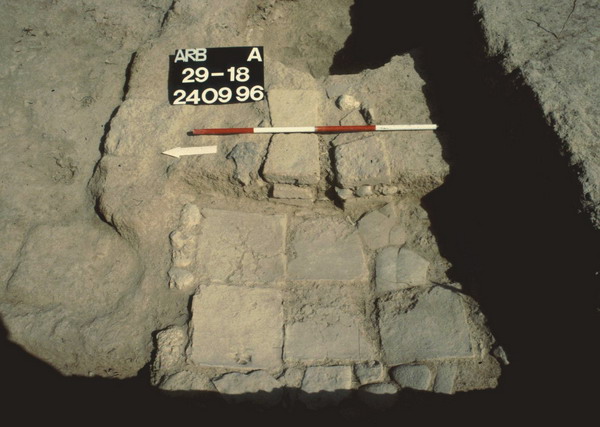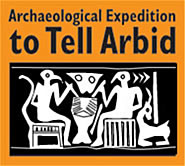SECTOR A
Sector A is located on the western slope of a small mound north-east of the main tell. Layers dated to the 2nd and 1st millennium BC and a quite extensive layer from the Hellenistic period were unearthed in this area.
Hellenistic Period
In 1997, two trenches were opened near the top of the mound, where a Late Hellenistic layer was revealed just below an abandoned modern house. Excavations were continued in this section in 2002. To judge by the results of the two seasons, the Hellenistic settlement that followed the earlier 1st millennium BC occupation was of a farm-type. A building with walls up to 1 m wide and two big courtyards dated to this period was unearthed. The smaller of the courtyards contained remains of several domestic installations, such as pits and a large bin made of mud brick. A Hellenistic bronze coin with Demetrios Nikator comes from this place.
The second and larger courtyard was filled with debris, which yielded a terracotta woman's head from the Hellenistic period, as well as some Roman cooking pots of the brittle ware. The earlier Hellenistic layer was found only in the north-western corner of the area (a large wall parallel to the later outer wall of the Late Hellenistic Building).
Of Hellenistic date were numerous pits, which had wrought havoc with the pre-Hellenistic remains. Some of the pits were up to 2 m in diameter and over 2.5 m deep, cylindrical or bell-shaped. They may have been prepared for storage and waste purposes.
They were filled with typical household refuse: ashes, animal bones and potsherds, although an Assyrian cylinder seal (of fired clay) as well as a complete bone knife, most probably of Hellenistic date were also found. These pits were concentrated mostly in the western sector of the hill, which must have been a kind of granary area for the Hellenistic farm, with different stages of functioning.
The rich collection of locally made pottery, red slipped included, and numerous terracotta animal figurines and coins attest to the well being of citizens of the farm.
Neo-Babylonian Period
Neo-Babylonian remains, deposited just under the Hellenistic strata were scanty. They were represented mostly by several domestic installations such as bins with plastered walls, tannours, and small pits. Of architectural features worth mentioning is a fragmentary structure encompassing at least two relatively small rooms and a single-roomed house. The latter was quite long - at least 8 m, and 6.5 m wide; its function is unknown. Also in a neighbouring trench a similar structure was discovered.
Mitannian Period
Important, albeit heavily disturbed archaeological remains representing the Mitannian period were discovered in the western part of the area A. They consisted of two strata, both of which yielded mud brick structures of clearly domestic character. The largest piece of Mitannian architecture was provisionally designated "Mitannian Northern House". Analysis of the bonding pointed to numerous reconstructions of the building. It was over 10 m long, about 5 m meters wide and had at least three rooms. A door socket of basalt stone near the north-western corner of the house marked the place of the main entrance to he building. An interesting feature of its furnishig was a heating stove mounted on a low podium in one of the rooms.
The Mitannian Northern House was equipped also with a drainage system made of reused ceramic potstands and a fragment of a ceramic pipe, probably designed to remove water from the building. Of special interest are also the remains from an older phase: a narrow street and at least two houses. In one of the houses a bathroom with a toilet was unearthed. It was paved with fired mud bricks and encircled with a narrow channel. Small finds from this period include a fragment of a clay bulla with two incomplete impressions of the same cylinder seal, evidently a Mitannian cylinder of 17th/ 15th century BC.
Explorations east of the Mitannian Northern House brought to light a structure, which looks like a floor paved with upended bricks or, it could be interpreted also as a fallen wall. Two complete Mitannian potstands were set between the bricks of this structure. The function of this unique structure is unknown, all the more so there were no remains of other architectural units around it.
 back to research page
back to research page top
top










